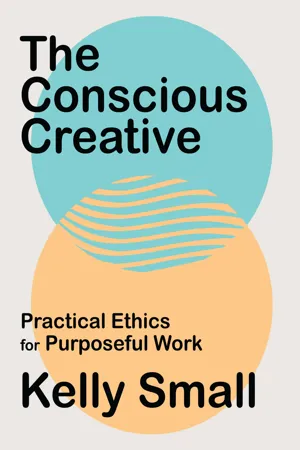![]()
Chapter
Three
Social
Actions
![]()
Cultivate empathy
Connecting to the needs and aspirations of others is crucial to socially conscious creative projects. Empathy has been described as a state that “requires us to put aside our learning, culture, knowledge, opinions, and worldview purposefully in order to understand other peoples’ experiences of things deeply and meaningfully.” This applies as much to our audiences as it does to our colleagues, clients, employees, and students.
Conscious creatives can tap into our empathy as a tool to enhance our understanding and capacity to connect with our collaborators and audiences. We can take this a step further. By committing to deep research, we can unearth insights that, when effectively shared in the messages we infuse our projects with, can gently nudge our audiences to tap into their own empathetic selves. We can, thereby, instill heightened levels of compassion, understanding, and connection in the folks engaging with our projects.
![]()
Start small in social impact
The social impact space can be riddled with life’s big questions, and it’s easy to get overwhelmed by seemingly unsolvable, intensely complex problems. A good place to start is to try not to get weighed down with the gravity of the problems society faces. We can start small. Contribute at a local level with the people we know and trust. Approach our projects one step at a time, starting with the concerns of our local communities. Work collaboratively to make change where we can. If we’re still feeling motivated once we have tackled local-level problems, we can move on to the global initiatives.
![]()
Get obsessed with accessibility
The numbers are no joke. Over 4.4 million people in Canada and 61 million in the United States are considered disabled. That means a whopping one in four Americans lives with some sort of disability — some are visible, some are not. With an ageing population, this number is only set to rise. It is an absolute necessity for any ethical creative practitioner to ensure that our creative output is as accessible as it can be. We can begin by familiarizing ourselves with the accessibility resources available through government and industry bodies found in the Resources section (see page 203), including government accessibility standards, Web Content Accessibility Guidelines, accessible fonts, descriptive text, universal access symbols, and the principles of inclusive and universal design.
Accessible creative output and practice should also be inclusive. An important aspect of creative inclusivity is ensuring that a diverse set of decision makers are represented throughout the process of working on a project. That means people with differing abilities — physical, cognitive, mental health, et cetera — support key creative decision making throughout. Live by the mantra popularized in 1990s disability activism: “Nothing about us without us.”
![]()
Champion inclusivity
The truth is that discourse in the creative industries has been largely dominated by cisheteropatriarchal Anglocentric/Eurocentric ways of knowing, seeing, and acting in the world. In other words, the groups of practitioners talking about design, architecture, tech, and the like have been pretty homogenous — cisgender, straight, male, and white. As a conscious creative, it’s crucial to get real with ourselves and see beyond Western perspectives. Let’s actively seek to expand the richness of knowledge that influences our work.
It bears repeating: In order to practice more inclusively, represent authentically, develop truly accessible output, and approach issues with a depth of understanding, we must aim to maximize the diversity of voices on project teams and start listening more deeply. We can actively notice cultural and experiential similarities and differences without making value judgements and be inquisitive when we encounter something we don’t understand. We can work to understand the nuances that exist in a culture or subculture and respect the unique worldviews that result from those experiences, rituals, languages, religions, histories, and politics that differ from our own. Doing so will significantly increase our sensitivity as we interact with and represent people in our work. It can also mean the difference between perpetuating harmful, discriminatory practices and committing respectful and reconciliatory speech and action.
![]()
Commit to reconciliation and decoloniality
For those of us not from historically oppressed peoples, this is a topic best approached with mindfulness of our own privilege and a commitment to park (indefinitely) any lingering fragility. Education, reconciliation, and decoloniality as they relate to the systemic oppression and genocide of racialized peoples, including Black and Indigenous communities, are complex and utterly crucial undertakings. Conscious creatives, especially white folks whose cultural histories are steeped in oppression, must commit to informing themselves about historical and contemporary injustice, systemic inequity, and the brutal generational ramifications of both. This knowledge is essential to creating work that centres social justice.
Unsure where to start? We can read more books, get connected to social justice organizations, and make efforts to dismantle the racist lens through which many of us experience the world. We can support networks with our time and talent, amplify voices, contribute financially, and promote opportunities for BIPOC (Black, Indigenous, and People of Colour), QTPOC (Queer and Trans People of Colour), and other marginalized groups. We can be mindful about the Indigenous histories of the land we occupy and learn to acknowledge it as such. We can ensure that our research, curriculums, and choices in creative inspiration are informed by Black and Indigenous knowledge as well as that of other communities whose histories and wisdom have been historically suppressed.
This short exploration of incremental actions cannot do...
